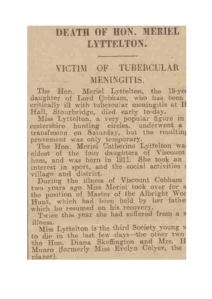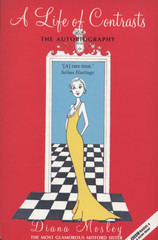There are many cliches about death, though one cannot deny that the British upper-class were quite matter-of-fact about their own immortality. In her essay on U and Non-U English, Nancy Mitford teases that, when referring to death, the Non-U lot were prone to using floral euphemisms: passed on, passed away, taken and gone-too-soon; to name a few. However, as she warned, the upper-class were blunt about the entire thing. Died, was their chosen expression when speaking of the death act. Yes, this lot with their hunting, shooting and fishing were well equipped for bloodshed and the sight of a corpse. Though, as silly as Nancy could be, there was no humour to be found when a dark shadow of death fell upon London society in 1930. Perhaps the cliche is true: that death, when it visits, it arrives in threes.
The Hon. Diana Elizabeth Margaret Skeffington, born in 1909, was the eldest child and only daughter of Viscount Massereene & Ferrard and his wife, the paranormal expert, Jean Barbara nee Ainsworth. Growing up at the family seat, Antrim Castle, in Co. Antrim, Northern Ireland, Diana was often included in her parents’ trips abroad and she was acquainted with their contemporaries, and was (falsely) rumoured to have caught the eye of Edward, the Prince of Wales. Though, as romantic as the story seems, there is no proof of their phantom courtship. As a little girl, Diana was a member of the Antrim branch of the Girl Guides – later becoming the leader of the Primrose Patrol – and many of her childhood companions were the children of local merchants. It was quite unheard of for a girl from her background to mix so freely with non-aristocrats, and one such friend, Sadie, was a fellow Girl Guide and the daughter of Viscount Massereene’s gardener. Escorted by her governess, Miss Molloy, Diana visited Sadie at her home on Castle Street, causing her mother great embarrassment each time their aristocratic caller entered through the backdoor and passed through the scullery.
As much as Lady Massereene (Diana was extremely close to her mother) thought it charming that her daughter had an eclectic mix of friends, for she, too, was a firm favourite amongst the locals, it was time for Diana to grow up and enter the life of a debutante. A dazzling star on the Mayfair scene and equally as popular in hunting circles in Scotland, Diana’s dark looks attracted many admirers and, perhaps, she would have made a splendid society marriage. This seemed to be in the future, when at the age of 20, she became Godmother to the future Earl of Scone. On the 15th October 1930, Diana served as a bridesmaid at the society wedding of her friend Miss Susan Roberts to the Hon. Somerset Maxwell Farnham. On this day, she asked for a glass of water – a seemingly harmless gesture, but the water was contaminated and a week later, Diana collapsed at her mother’s family home, Ardanaiseig House, in Argyll. The diagnosis was typhoid fever and a doctor in Harley Street had been alerted of her condition and the necessary arrangements were made for her to travel south for treatment. Hopes were raised when Diana claimed to feel better, and on Trafalgar Day, she took to the streets of London to sell flags in aid of servicemen. It was a cold day and her friends were concerned about her fragile appearance and urged her to the family home at Rutland Gate. ‘If I go to bed now, it will be weeks before I shall be up again,’ she joked. Suddenly all expectations of a complete recovery were dashed when Diana – still battling typhoid – developed pneumonia and her condition took a turn for the worse. The raging fever consumed her and, on the 6th November 1930, she died aged 21.
Although not the daughter of a Peer, Evelyn Colyer gained recognition through her own merits on the tennis court. Alongside Joan Austin, she played doubles in the 1923 Wimbledon final against Suzanne Lenglen and Helen Wills. With her modern looks and model appearance in her tennis-whites, the press nicknamed Evelyn as one of ‘The Babes’. In 1924, she paired with Dorothy Shepherd-Barron to win a bronze medal in the women’s doubles at the Paris Olympics. For nine years Evelyn competed in the Wimbledon Championships, and her final match was in 1929, after which she retired from tennis to marry Hamish Munro, a tea-planter from Assam, British India. Returning to her husband’s homeland, Evelyn died from complications in childbirth on the 6th November 1930, aged twenty-eight.
The Hon. Meriel Catherine Lyttelton was the eldest daughter of John Cavendish Lyttelton, 9th Viscount Cobham and Violet Yolande Leonard. With her brown hair, glassy blue eyes and pale skin, she radiated an ethereal beauty. Although she was a popular debutante and a leading figure of London society, Meriel preferred her life in Gloucestershire where she immersed herself in country life, paying close attention to the social activities in the village and participating in blood sports. When her father, the Viscount, fell ill, she took over his role of Master of the Albright Woodland Hunt, a position she held for two years until his recovery.
In 1930, Meriel had been weakened from two bouts of serious illness before she was stricken by tubercular meningitis, for which she received a blood transfusion. Despite it providing some temporary relief, and offering false hope to her parents, this illness proved fatal and Meriel died aged 19 on the 11th November 1930. Her younger sister, Viola, went on to marry Robert Grosvenor, the 5th Duke of Westminster. Although Viola, too, met a tragic end when she died in a car accident in 1987 in Co. Tyrone, Northern Ireland, this was perhaps the fulfilling life Meriel might have lived had she not died young.











